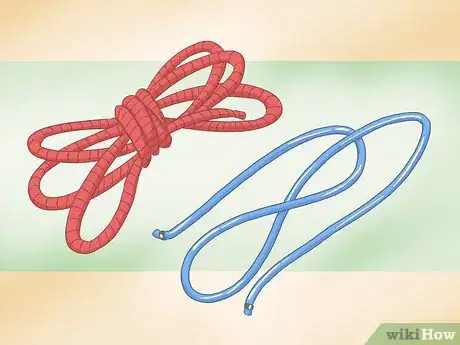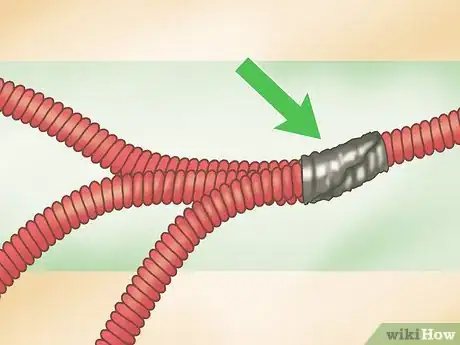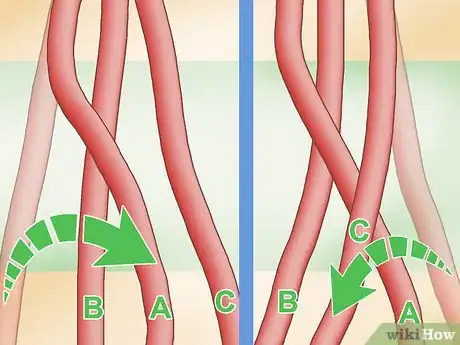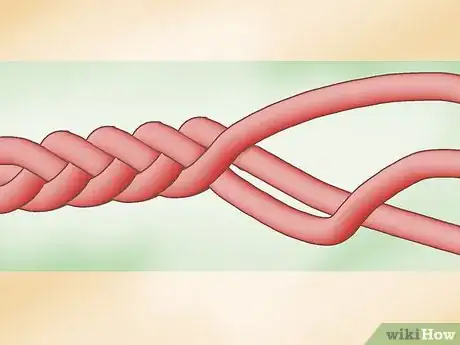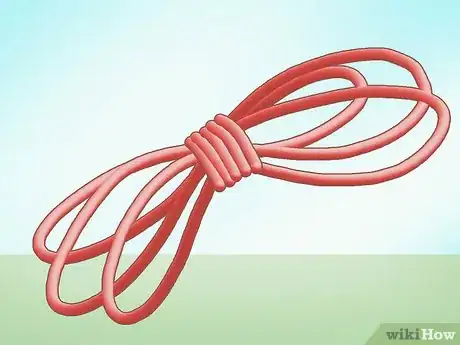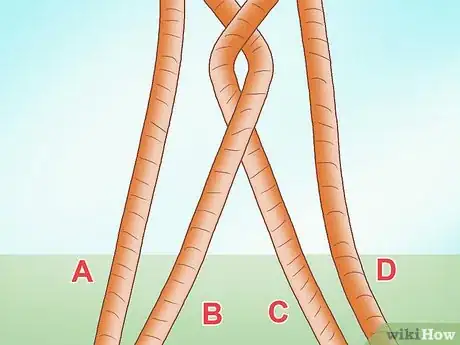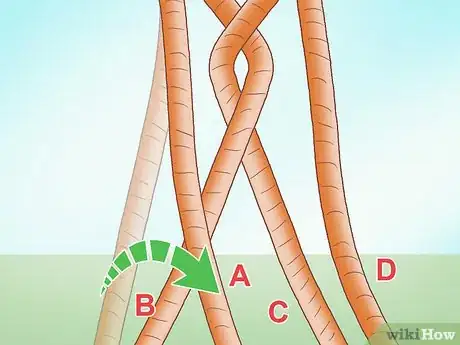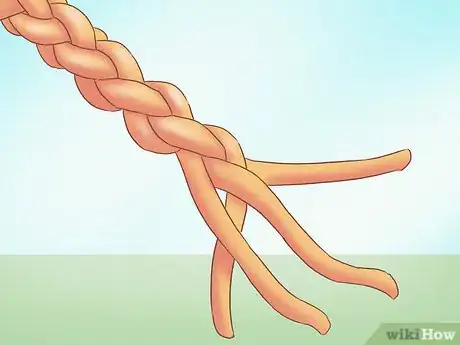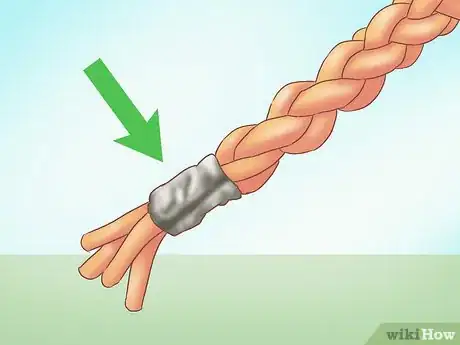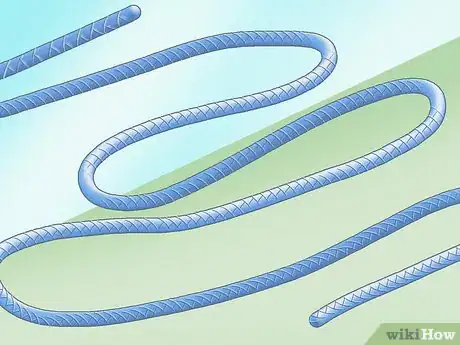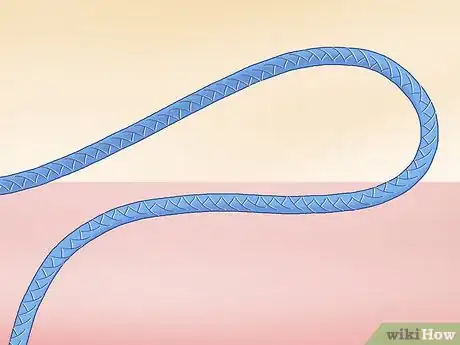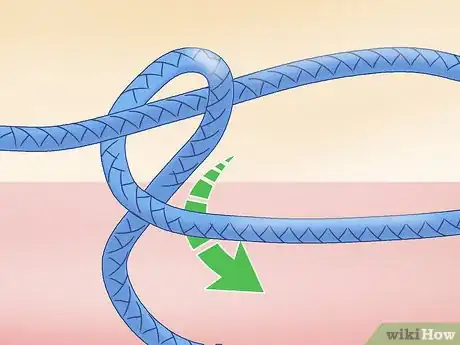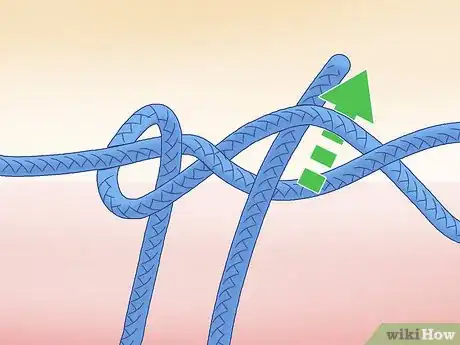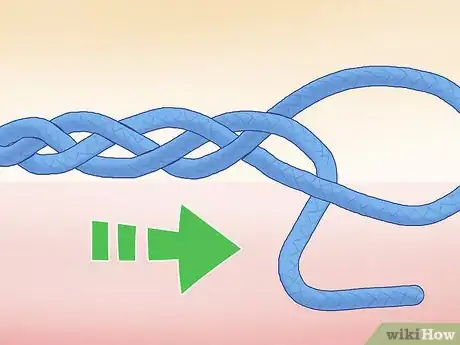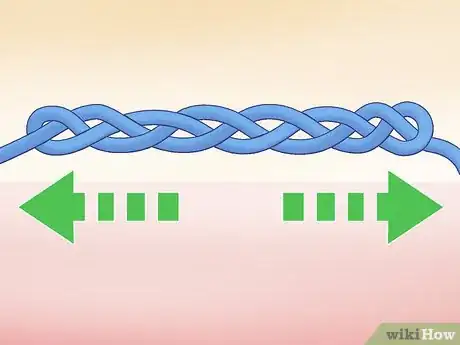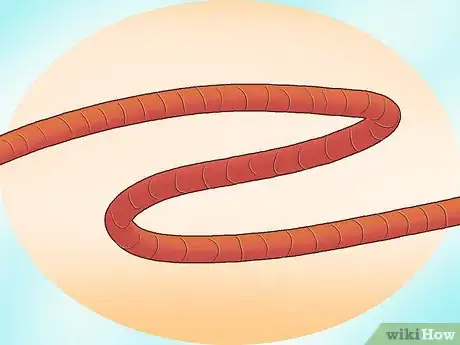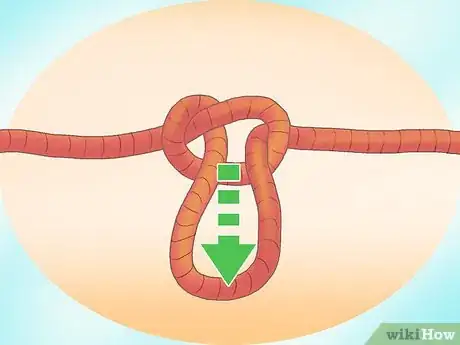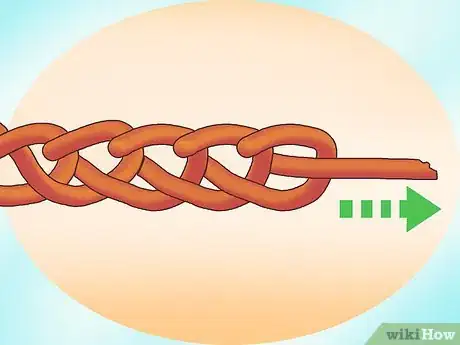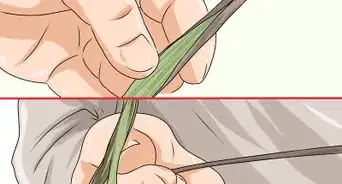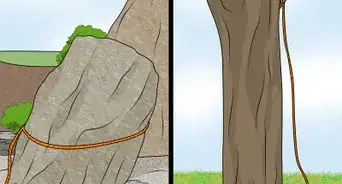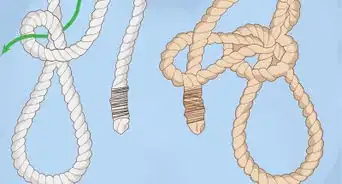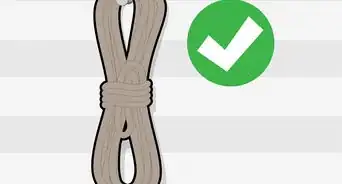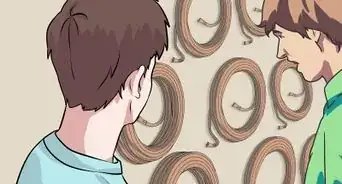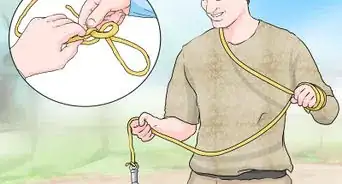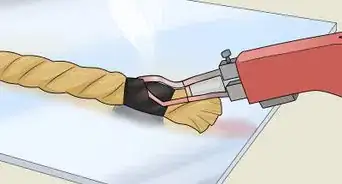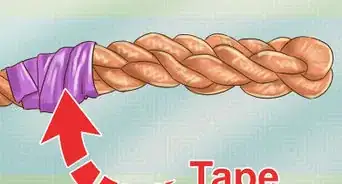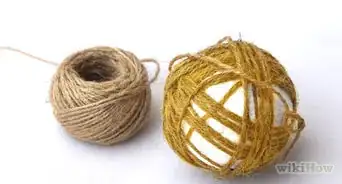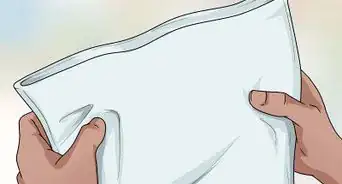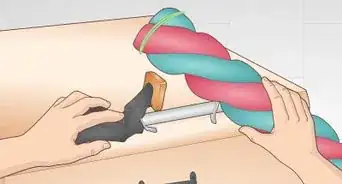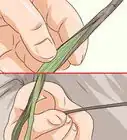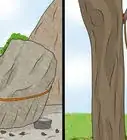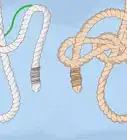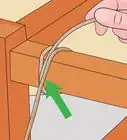This article was co-authored by Nicole Bolin. Nicole Bolin is a Crafting Specialist and the CEO of Stencil, a DIY Craft Studio in Phoenix, Arizona. Nicole specializes in interior design and various craft and DIY projects. Nicole holds a Certificate in Interior Design from the New York Institute of Art and Design. She opened Stencil in 2017 to teach others to create DIY projects that fit their home and lifestyle.
There are 12 references cited in this article, which can be found at the bottom of the page.
wikiHow marks an article as reader-approved once it receives enough positive feedback. In this case, 100% of readers who voted found the article helpful, earning it our reader-approved status.
This article has been viewed 240,388 times.
Braiding rope gives the material additional durability and makes the finished product more versatile for use in a variety of applications. There are a few different ways you to braid rope when you only have a single strand, or you could join several ropes or strands together to create something even stronger.
Steps
Making a Three-Strand Braid
-
1Start with the rope of your choice. A three-strand braid is a very common way to braid, perhaps most associated with a classic schoolgirl hair braid. You can use this technique to make a strong braided rope. Braided ropes are appropriate for use in high-friction situations.[1] You can use more or less any type of rope material for this method, including synthetic rope, natural rope and plastic cords. It just has to be flexible enough that you can work with it. If the ends of your strands are frayed, fuse them before you begin.
- With a synthetic rope you can fuse the end by holding it over a candle so that it melts a little and fuses together.[2]
- You can tie twine (dental floss works well) around the end portion of the strand to bind it together. This practice is known as “whipping.”
- You can also use tape to secure the ends of the strands, and prevent fraying.
-
2Bind the three ends together. Use a knot or some tape to securely bind the ends of your three strands. Electrical tape and gaffer tape are good choices, depending on how thick the strands you are using are. Once you have bound the strands together at the left-hand side, stretch out the rest of the rope towards the right-hand end.
- The three strands should be lying next to each other and not overlapping to get your starting position.[3]
- You may find it helpful to label the three strands A, B, and C.
- You could also color-code the strands, or use different colors if you want to make a pattern.
Advertisement -
3Pass the outside strands across the central one. Start by crossing strand A over the central strand B. The order of strands will now be B, A, C. Next cross the other outside strand across the newly central strand, C over A. Now the order will be B, C, A. This is one basic repetition of the braiding pattern for a three-strand braid.[4]
-
4Repeat the outside to in pattern. Continue repeating this pattern of crossing one outside strand over the central strand, and then crossing the other outside strand over the new central strand.
- In this example you would now cross B over C, so that B is the central strand.
- Then you would cross A over B so that A is the central strand.
- You can continue this pattern until you reach the end of the length of rope.
-
5Tie off the rope. Once you have reached the end of the rope, you can secure the braid by binding the strands together. You can do this by taping the ends together with electrical tape or gaffer, or by tying a strong knot at the end.
Making a Four-Strand Braid
-
1Start with flexible cord. This technique requires four pieces of cord with good flexibility, since you will be braiding together multiple strands, so you need to ensure whatever type of rope material you use is flexible enough for you to work with. It will be hard to get a tight braid with something that is too stiff.
- A four-strand braid is a good choice for a high-friction use, such as in winches and pulleys.[5]
- Ensure that each strand is fused at the end, either by melting the end of a synthetic rope, or by tying or taping a natural rope.[6]
- The extra strand over a three-strand brand should make the rope thicker and stronger.
-
2Join the ends together. For this braiding technique, you will need to knot or fuse together four strands of rope. There are a few different ways to do this, but the easiest is to simply tie a knot joining four pieces of rope together at one end. You could also secure them with some electrical tape or gaffer tape.[7]
- You can work with four separate pieces of rope, or you could bend two pieces of rope in half and treat the two ends of one piece as two strands, thereby giving you a total of four strands.
- You can also use eight strands of rope as long as you work in bunches of two, essentially treating two strands as one.
- For the sake of this tutorial, the four strands will be labelled as A, B, C, and D. Strands B and C are the centre two strands.
-
3Cross the middle strands together. Cross strand C over strand B. Wrap C around B so that it first crosses over B before eventually winding underneath it and back to its original position in the cluster.
- When you are finished with this step, the ends of all four strands should still be in the same order they were in at the start.
- The order should be A, B, C, D.[8]
-
4Cross one end over the middle. Bring strand A over strand B. Do not cross A over C. At the end of this step, the order of the strand ends should be B, A, C, D.[9]
-
5Weave the remaining end in. Pass strand D underneath strand C. Bring it up from the other side of C and pass it over Strand A. Do not cross D with B.
- At the end of this step, the order of the strand ends should be B, D, A, C.
- You have completed one braiding block at the conclusion of this step.[10]
-
6Repeat this pattern down the length of the rope. Follow the same pattern used to complete the first braiding block down the length of the rope until you make the braid as long as you need it to be or until you are nearly out of rope.
- At the start of each round, re-label the strands as A, B, C, D according to the order they are now in.
- Wrap C around B.
- Bring A over B.
- Cross D under C and over A.
-
7Join at the other end. Once the braid is complete, you need to join the four strands at the finishing end of the rope. You can fuse them together or create a knot to hold them in place.[11]
Doing a Standard Single Rope Braid
-
1Start with a flexible single cord. A single braided rope offers the strength of braided rope, but is more lightweight as it involves only one strand. A synthetic or natural rope could work, but it has to have a high level of flexibility so that you can work with it. A stiffer cord will not really work with this method. It can be any length depending on what you want to use it for.
- Single-braided ropes are often used for rigging and pulling and climbing.[12]
- Do not use a rope you have made yourself for climbing unless you have had it checked out by an expert who can vouch for its suitability and safety.
-
2Make a loop with the rope. If you are doing a single rope braid, you will be braiding a section of the rope. When you know how long you want the braided section to be, make a loop in the rope that is about that size.
- You can do this just by sliding the two ends of the rope towards the centre.
- For this example, have the right side of the rope above the left side.[13]
-
3Pass one free end through the loop. Once you have your loop, bring the end of the rope from the right-hand end up and through the left-hand side of the loop in an over and under movement. Your main loop should now have a smaller loop on the left-hand side and the right-hand end of the rope should be below the loop.[14]
-
4Twist the loop. Bend the top of the loop down so that it crosses over the bottom end of the original loop. Make this crossover near the first braid of your rope and not toward the open end of the loop. This will create the beginnings of a braid-like pattern and create the hole that you will then pass the right-hand end of the rope through.
- As you cross the rope over itself, the original top portion of the loop should cross back over the original bottom portion of the loop, just a short distance away from the new intersection you created.
- As a result, a new, smaller loop or hole should form just past the original link of your braid.[15]
-
5Pass the end through the newly created hole. Insert the right-hand end of the rope through the hole you just created in the previous step. This action forms another link in the braid.
- The right-hand end of the rope will go through the hole by going over the bottom portion of the loop and under the top portion of the loop.
- The right-hand end should now be angled upward, above the rest of the rope.[16]
-
6Repeat down the length of the rope. You will need to continue making new, small loops from the larger loop by twisting the rope, and then weaving the right-hand end of the rope through the holes that are created. The braid is complete once you no longer have enough of the large loop to work with and use for the creation of new sub-loops.
-
7Tighten the braid. When you twisted the loop for the last time, thread the right-hand end of the rope through the final small loop. Carefully pull on both ends of the rope to tighten the braid.[17]
Doing a Monkey Braid
-
1Start with a flexible single cord. To make a Monkey Braid (or Chain Sinnet) you only need a single strand. Monkey braids can add bulk, or shorten a rope. They are often used as a way to store rope without it getting tangled up.[18] You can use synthetic or natural rope, but ensure that the material is flexible so that you can work with it. Plastic cords tend to be quite stiff, which can prevent you from getting a tight single-strand braid.
- You can use a Monkey Braid to make a nice looking chain, which returns to a straight rope when pulled.
- You often see these braids on dress uniforms.
-
2Make a loop. For this technique you need to start by making a loop in the rope by pushing the right-hand end of the rope towards the left-hand until a loop pops up. The point where this loop starts will be where the braid starts so ensure that the loops start near to the left-hand end of the rope.[19]
-
3Push the long side through the loop. Once you have a loop you need to take the rope from the long end (the right-hand side) and push it through the loop. You are pushing the part of the rope that is closest to the loop on the right-hand side. Only use a small section of the rope.[20]
- You should be pulling a small U-shaped portion of rope through your initial loop to create a second loop.
- Pull it down, through the loop and out, tugging it toward the working side of the rope to tighten it slightly.
- Note that it is easier to tighten each loop as you work when using this braiding method. Trying to tighten the loops once you finish the entire braid can cause the braid to be loose and uneven overall.
-
4Turn the u-shaped part into a new loop. Once you have pulled the u-shaped part of rope through the loop pull it to the right hand side so that is in line with the braid and the loop that you just pulled it through.[21]
-
5Create another loop. Pinch another section of rope from the working end (the right-hand side), again making sure that it is directly next to the loop you just created. Push it under, through, and out of the loop on the end of the braid, tugging gently to secure it.[22]
-
6Repeat through the length of the rope. The rest of the braid is completed simply by making new loops from the working side of the rope and pulling those loops the larger loops. Pinch another section of rope from the working end. Push this section under and through the previous loop made in the rope.
- Repeat this as necessary down the length of the rope.[23]
-
7Pass the end through the final loop. When you have enough braids in the rope, create one special final loop to pass the finishing end through. To create a locking loop at the end pass the working end (right-hand end) of the rope over the top side of the last loop and through it.[24] Pull snug on both loose ends of the rope to tighten the braid securely.
Tips
- Looking for a way to incorporate braided rope into arts and crafts projects? Buy a glass jar and use a glue gun to wrap the rope around the jar from top to bottom.[25]
- Don't put the braid rope on the candle, because it might catch on fire.[26]
- You could also probably use braided rope for a macramé wall hanging.[27]
Community Q&A
-
QuestionI have a three strand upholstery rope trim for a chair that I need to attach to the other end of same rope. What is the best way to do this without fraying it?
 T. ChinsenTop AnswererDepending on whether the join is going to be visible or hidden, there are two options. For both options, the two ends of the rope need to be treated with glue. Sobo glue does not yellow and dries clear and is waterproof when dry. E6000 glue will not soak into the fiber on its own. By soaking the rope with a little acetone, the glue will thin out and be absorbed. If the join will be hidden, the ends can be overlapped and wrapped with another thread. If the join is visible, overlap (side by side) the glued ends and, using a razor blade, cut both cords diagonally. Glue the diagonal cut edges together. The join can also be wrapped with invisible thread or thin fishing line for strength.
T. ChinsenTop AnswererDepending on whether the join is going to be visible or hidden, there are two options. For both options, the two ends of the rope need to be treated with glue. Sobo glue does not yellow and dries clear and is waterproof when dry. E6000 glue will not soak into the fiber on its own. By soaking the rope with a little acetone, the glue will thin out and be absorbed. If the join will be hidden, the ends can be overlapped and wrapped with another thread. If the join is visible, overlap (side by side) the glued ends and, using a razor blade, cut both cords diagonally. Glue the diagonal cut edges together. The join can also be wrapped with invisible thread or thin fishing line for strength. -
QuestionIs there a way to do the single strand braid then turn it into a monkey fist?
 T. ChinsenTop AnswererIt would require sections of single strand braid to be made as you go. It will get difficult to move and adjust the strands when tightening the monkey fist due to the multiple strands of the braid. The braided cord tends to lock up as it is pulled tight.
T. ChinsenTop AnswererIt would require sections of single strand braid to be made as you go. It will get difficult to move and adjust the strands when tightening the monkey fist due to the multiple strands of the braid. The braided cord tends to lock up as it is pulled tight.
References
- ↑ https://www.usnetting.com/rope/selection-guide/
- ↑ http://www.ropeworks.biz/reader/fusing.pdf
- ↑ http://www.animatedknots.com/braidthreestrandone/index.php?Categ=decorative&LogoImage=LogoGrog.jpg&Website=#ScrollPoint
- ↑ http://www.animatedknots.com/braidthreestrandone/index.php?Categ=decorative&LogoImage=LogoGrog.jpg&Website=#ScrollPoint
- ↑ https://www.usnetting.com/rope/selection-guide/
- ↑ http://www.ropeworks.biz/reader/fusing.pdf
- ↑ http://www.animatedknots.com/fourstrandwidened/index.php?Categ=decorative&LogoImage=LogoGrog.jpg&Website=#ScrollPoint
- ↑ http://www.animatedknots.com/fourstrandwidened/index.php?Categ=decorative&LogoImage=LogoGrog.jpg&Website=#ScrollPoint
- ↑ http://www.animatedknots.com/fourstrandwidened/index.php?Categ=decorative&LogoImage=LogoGrog.jpg&Website=#ScrollPoint
- ↑ http://www.animatedknots.com/fourstrandwidened/index.php?Categ=decorative&LogoImage=LogoGrog.jpg&Website=#ScrollPoint
- ↑ http://www.itstactical.com/skillcom/climbing/how-to-make-a-fast-rope-for-climbing/
- ↑ http://www.westechrigging.com/rope---cordage.html
- ↑ http://www.animatedknots.com/braid/index.php?Categ=decorative&LogoImage=LogoGrog.jpg&Website#ScrollPoint
- ↑ http://www.animatedknots.com/braid/index.php?Categ=decorative&LogoImage=LogoGrog.jpg&Website#ScrollPoint
- ↑ http://www.animatedknots.com/braid/index.php?Categ=decorative&LogoImage=LogoGrog.jpg&Website#ScrollPoint
- ↑ http://www.animatedknots.com/braid/index.php?Categ=decorative&LogoImage=LogoGrog.jpg&Website#ScrollPoint
- ↑ http://www.animatedknots.com/braid/index.php?Categ=decorative&LogoImage=LogoGrog.jpg&Website#ScrollPoint
- ↑ http://www.animatedknots.com/chainsinnet/index.php?Categ=decorative&LogoImage=LogoGrog.png&Website=www.animatedknots.com#ScrollPoint
- ↑ http://www.animatedknots.com/chainsinnet/
- ↑ http://www.dailymotion.com/video/xjkioe_chain-sinnet-monkey-braid-how-to-tie-a-chain-sinnet_shortfilms
- ↑ http://www.animatedknots.com/chainsinnet/
- ↑ http://www.animatedknots.com/chainsinnet/
- ↑ http://www.dailymotion.com/video/xjkioe_chain-sinnet-monkey-braid-how-to-tie-a-chain-sinnet_shortfilms
- ↑ http://www.dailymotion.com/video/xjkioe_chain-sinnet-monkey-braid-how-to-tie-a-chain-sinnet_shortfilms
- ↑ Nicole Bolin. Crafts & DIY Specialist. Expert Interview. 29 October 2020.
- ↑ Nicole Bolin. Crafts & DIY Specialist. Expert Interview. 29 October 2020.
- ↑ Nicole Bolin. Crafts & DIY Specialist. Expert Interview. 29 October 2020.
About This Article
To braid rope, first take 3 identical lengths of rope and wrap some electrical tape around the ends to hold them together. Lay the three lengths down with the bound side closest to you. Then, take the rope on the right and lay it over the rope in the middle. Repeat this process with the rope on the left by laying it in between the two you just crossed. Pull the three lengths away from the center to tighten the braid. Now, spread your new three lengths out away from the first braid. Repeat this process again, starting with the rope on the right, and continue to braid the rope. Once you get to the last braid, tie the rope off with a new piece of tape, a fourth length of rope, or by tying a tight knot. If you want to learn how to do a single rope or monkey braid, keep reading the article!
